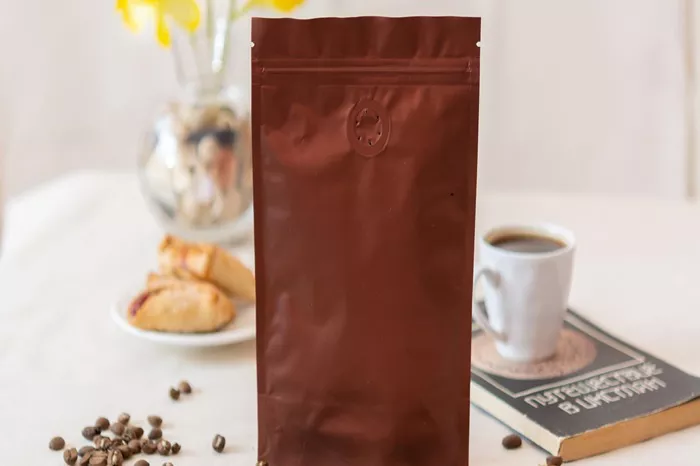If you’ve ever purchased a bag of freshly roasted coffee beans, you may have noticed a small hole or valve on the packaging. While it might seem like an unusual feature, this small hole plays a crucial role in maintaining the quality and freshness of your coffee. The hole is actually part of a one-way valve designed to allow carbon dioxide (CO2) to escape from the bag after the beans have been roasted. Here’s an in-depth look at why there’s a hole in coffee bags and how it helps preserve your coffee’s flavor.
Purpose of the Hole: The One-Way Valve
The hole in coffee bags serves an important purpose: it’s part of a one-way valve that allows the release of gases without letting anything else in. After coffee beans are roasted, they undergo a natural process called degassing, during which they release carbon dioxide (CO2) that was trapped during roasting. The one-way valve provides a safe and controlled way for this gas to escape from the bag, preventing it from affecting the beans and the bag itself.
The Degassing Process
When coffee beans are roasted, chemical reactions take place that release CO2. This gas is a byproduct of the roasting process and continues to escape from the beans for several days after roasting. If this CO2 is trapped inside the bag without a way to escape, the pressure can build up, potentially damaging the packaging. The one-way valve ensures that the CO2 can safely leave the bag without allowing oxygen or moisture to enter.
The degassing process is essential because freshly roasted coffee beans are highly volatile. CO2 can significantly affect the aroma and flavor of the beans, and without proper ventilation, the build-up of gas could lead to a loss of freshness.
Preventing Bag Rupture
One of the most practical reasons for the hole in coffee bags is to prevent the packaging from rupturing due to the accumulation of CO2. If the gas isn’t allowed to escape, the bag may begin to puff up or even burst open. This can be particularly problematic for vacuum-sealed or tightly packed coffee bags, where the gas buildup would otherwise cause the bag to fail. The one-way valve prevents this by offering a safe escape route for the gas, ensuring that the bag maintains its integrity.
Without this valve, there could also be a risk of the packaging becoming unsightly or less practical for storage. The pressure from trapped CO2 could distort the shape of the bag or even cause it to tear, which would compromise the quality and presentation of the coffee.
Maintaining Freshness
The valve in coffee bags also plays a vital role in maintaining the coffee’s freshness. After roasting, coffee is at its peak freshness and flavor, but this rapidly begins to degrade once the beans are exposed to oxygen, light, and moisture. The one-way valve allows CO2 to escape without letting air or moisture enter the bag, which helps preserve the beans’ natural oils and flavors. Without this protection, exposure to oxygen can lead to the oxidation of the beans, causing them to stale more quickly.
By allowing the gas to escape while keeping oxygen out, the valve extends the shelf life of the coffee and ensures that the beans maintain their rich aroma and flavor for a longer period.
Ensuring Consistent Coffee Quality
For coffee lovers, consistency in flavor is key. If CO2 is allowed to accumulate inside the bag, it can affect the brewing process. When you grind the coffee and brew it, the CO2 that was trapped in the beans can interfere with the extraction process, creating bubbles in the coffee. These bubbles can prevent water from flowing through the grounds evenly, resulting in an inconsistent brew with uneven extraction and less optimal flavor.
By controlling the release of CO2, the one-way valve helps ensure that each cup of coffee is as smooth and consistent as possible. When the beans have had the time and space to degas properly, the flavor profile remains intact, making for a better and more balanced brew.
Packaging Variations: Not All Coffee Bags Have Valves
While many coffee bags feature this one-way valve, not all packaging methods include it. Some specialty coffee roasters prefer to let beans degas naturally before packaging them. This process involves allowing the coffee to rest for a few days in a controlled environment before sealing it in bags. While this approach can also maintain the freshness of the coffee, it typically requires more careful handling and timing.
Some bags, especially those used by smaller roasters, may have no valve at all. These bags are often sealed only after a period of degassing, when the beans have already released the majority of their CO2. In such cases, the bags will usually not experience the same pressure buildup because most of the gas has already escaped before packaging.
Conclusion
The hole in coffee bags, often in the form of a small one-way valve, is an important feature that plays a vital role in preserving the quality and freshness of your coffee. By allowing carbon dioxide to escape without letting in oxygen or moisture, the valve prevents bag rupture, maintains the coffee’s natural flavors, and ensures a more consistent brewing experience. Whether you’re enjoying your coffee fresh from the roaster or sipping it weeks after purchase, that small valve is a key player in keeping your coffee tasting its best.
Related topics:
- Why Luwak Coffee is Expensive?
- What Are the Factors of Coffee Demand?
- What Celebrity Owns a Coffee Shop?


